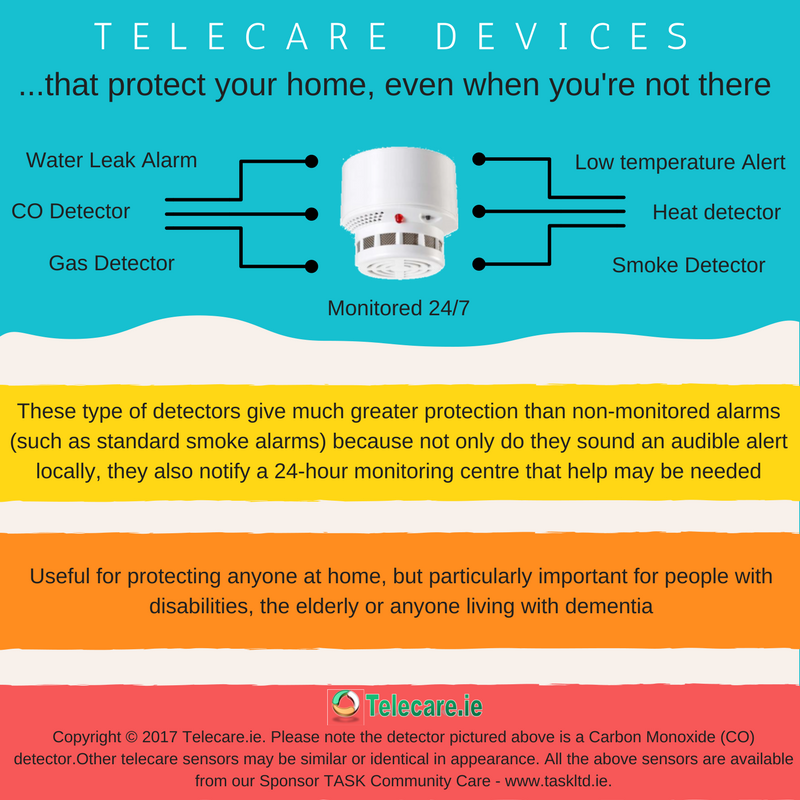
A group of telecare devices known as ‘environmental sensors’ can warn of potential household threats, such as smoke, carbon monoxide or water leaks. These detectors can be a lifeline for anyone with mobility problems such as frail elderly or people with disabilities, as the alarms give more protection than their non-monitored counterparts (such as standard smoke alarms). This is because the devices notify a 24-hour monitoring centre that help may be needed, in addition to sounding an audible alarm in the home. This increases safety as your life is not as dependent on hearing the detector.
Therefore, if you are at home but have taken sleeping tablets or for any other reason might not hear a detector, monitoring centre operators can take action. They can do so by attempting to call you on a mobile phone or by asking one of your nominated contacts to check in on you.
For anyone with restricted movement or mobility
problems such as frail elderly or people with disabilities,
monitored detectors can be a lifeline
Another advantage of this group of telecare alarms is that they protect your home, even when you’re not there.
Also, because monitoring centre operators are notified when a detector is activated, they can provide details on the location and type of detector. For instance if a smoke detector is activated, the fire brigade may need to be contacted. If so, the operators can let them know your address and also the room in which the smoke detector has sounded. Other important information which you have provided can also be given to emergency personnel, such as the code to a key-safe. This could prevent damage from forced entry, as well as speeding up entry for time critical events such as potential carbon monoxide poisoning.
Under the below graphic, you can find a short summary of six different types of monitored telecare alarms, that fall into the category of environmental sensors.

#1 MONITORED SMOKE DETECTOR
While a smoke detector can keep you safe from fire (& everyone should have at least one at home) it’s only useful if you hear the alarm. If you’re a heavy sleeper or have a hearing impairment and don’t hear it, you’re life could be at risk. A monitored smoke detector increases your protection and makes your home a safer place.
#2 MONITORED WATER LEAK DETECTOR
Water leak detectors can be placed next to the bath or below the wash basin. If you leave taps running and water spills over, this will send an alarm to the monitoring centre. These devices can prevent the hassle and expense caused by water spillage. They are a great investment for anyone who tends to get distracted or who has problems with their short term memory. Water leak detectors can also alert of burst pipes in winter, which is particularly useful if you are away from home.
#3 MONITORED GAS DETECTOR
Gas leaks often result from people forgetting to light a gas ring or gas fire. Leaks can also occur from natural causes such as a pilot light blowing out. Gas can also seep in from a neighbours home. It can build up to dangerous levels which can result in explosions. Gas detectors are high sensitivity alarms which give early indication of the presence of dangerous levels of natural gas, butane, propane etc. Always check with your telecare provider that you are buying the most appropriate type of gas detector for your home. They are a must if you are prone to leaving the gas on un-ignited at home.
#4 MONITORED CARBON MONOXIDE (CO) ALARM
Carbon Monoxide (CO) has no smell and can’t be seen, which means this poisonous gas is easy to inhale without knowing. The importance of having this type of detector is often underestimated. CO gas can come from many places in your home, including an open fire, cooker and boiler. If your carbon monoxide alarm is monitored, experienced call handlers in a monitoring centre will be available 24 hours a day, 365 days a year, for any time the detector is activated.
#5 MONITORED TEMPERATURE EXTREME SENSOR – HEAT
If you have an increased risk of fire in your home (for instance if you have an open fire or wood burning stove) it can be a good idea to have a heat detector fitted in addition to your smoke detector. Heat detectors are sometimes used in kitchens in situations where a smoke detector cannot be used, however they should not be used to replace the presence of smoke detectors in your home (as smoke detectors can often detect the presence of fire at an earlier stage). Discuss your options with your telecare supplier.
#6 MONITORED TEMPERATURE EXTREME SENSOR – COLD
The low temperature/hypothermia alarm is designed to alert older people to freezing winter temperatures, so that they or their family members are made aware of the need to put on more heating or wrap up warmer. If body temperatures falls too low, hypothermia can result. Hypothermia is a potentially fatal condition that occurs when the body cannot generate enough heat to compensate for the warmth it loses. You are more likely to develop hypothermia in certain scenarios such as if you are very old, very young or chronically ill (especially anyone who has heart or blood flow problems). Taking certain prescription medicines can also increase the risk. Symptoms can include sleepiness, clumsiness, and even slurred speech. Sufferers can become confused, meaning a timely alert from a low temperature sensor could save their lives.
The above devices can be added to existing telecare systems (depending on the make/model of your base-unit) to provide alerts when an emergency alarm is generated. As nearly all telecare systems use wireless technology, the installation in your home can be carried out quickly and with little disruption. You may be able to get the device programmed [to connect to your base-unit] by your telecare provider and then posted out to you. Ask telecare providers what options are available before you buy.
All the above monitored telecare devices are available from our Sponsor TASK Community Care. TASK’s annual telecare monitoring charges for individuals are at the time of writing: Ireland €66 / UK £52. When you choose TASK to monitor a telecare device for your home, they will monitor any other telecare devices linked to the same base-unit for no additional charge.
